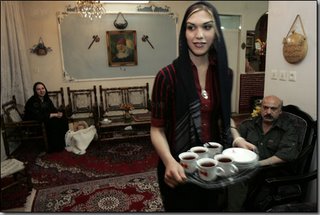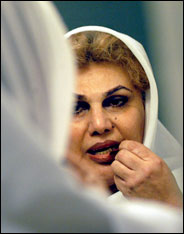
Before the Islamic Revolution in 1979, the issue of transsexuality in Iran had never been officially addressed by the government. Beginning in the mid-1980s, however, transgendered individuals have been officially recognized by the government and allowed to undergo gender reassignment surgery.
pic: Athena, a 20-year-old male to female transsexual in conservative Iran, brings tea to her father and her sister at her home in Tehran.
History
Pre-1979
In 1963, Ayatollah Ruhollah Khomeini wrote a book in which he stated that there is no religious restriction on corrective surgery. However, this applied only to intersexuals, and at the time Khomeini was a radical, anti-Shah revolutionary and his fatwas did not carry any weight with the Imperial government, which did not have any specific policies regarding transgendered individuals.[1]
After the Revolution
The new religious government that came to be established after the 1979 Revolution classed transsexuals and transvestites with gays and lesbians, who were condemned by Islam and faced the punishment of lashing and death under Iran's penal code.
One early campaigner for transsexual rights is Maryam Hatoon Molkara, who was formerly a man known as Fereydoon. Before the revolution, she had longed to become a woman but could not afford surgery. Furthermore, she wanted religious authorization. Since 1975, she had been writing letters to Ayatollah Khomeini, who was to become the leader of the revolution and was in exile. After the revolution, she was fired, forcedly injected with male hormone, and institutionalized. She was later released with help from her connection, and she kept lobbying many other leaders. Later she went to see Khomeini, who had returned to Iran. At first she was stopped and beaten by his guards, but eventually Khomeini gave her a letter to authorize her gender reassignment operation. The letter is later known as the fatwa that authorizes such operations in Iran.[2]
A small number of Iranian clerics have advised that homosexual men and women undergo gender reassignment in order for them to be able to live normal lives.
Contemporary status
Khomeini's original fatwa has since been reconfirmed by the current Supreme Leader of Iran, Ayatollah Ali Khamenei, and is also supported by many other Iranian clerics. [3]
[3]
pic: Maryam Hatoon Molkara, who was formerly a man known as Fereydoon, was an early campaigner for the rights of transsexuals in Iran.
However, there is still a great deal of stigma attached to the idea of transsexuality and gender reassignment in ordinary Iranian society, and most transsexuals, after completing their transition, are advised to maintain discretion about their past. Once a transgendered individual has undergone gender reassignment, that person legally becomes the proper gender - male, in the case of transgendered men, and female, in the case of transgendered women. All legal documents, such as birth certificates and passports, are also changed accordingly.
Hojatoleslam Kariminia, a mid-level cleric who is in favor of transgendered rights, has stated that he wishes "to suggest that the right of transsexuals to change their gender is a human right" and that he is attempting to "introduce transsexuals to the people through my work and in fact remove the stigma or the insults that sometimes attach to these people." [4]
UNHCR's 2001 report says that sex reassignment surgery is performed frequently and openly in Iran, and that homosexual and crossdressing people would be safe as long as they keep a low profile.[5] However, Safara Project's 2004 report considers UNHCR's report over-optimistic. Safara's report suggests that UNHCR underestimated legal pressure over LGBT.
The report further states that currently, it is not possible for transgendered individuals to choose not to undergo surgery - if they are approved for gender reassignment, they are expected to undergo treatment immediately. Those who wish to remain "non-operative" (as well as those who crossdress and/or identify as genderqueer) are considered their biological gender, and as such they are likely to face harassment as being homosexuals and subject to the same laws barring homosexual acts. [6]
References
External links
Source:
WikipediaWatch the trailer of a documentary on Transexuality in Iran:
 Get married in the night and break the 'thali' the next morning. This is the essence of the Koothandavar festival
Get married in the night and break the 'thali' the next morning. This is the essence of the Koothandavar festivalMahabaratha is celebrated every year in grand style. According to the Mahabaratha, Rajakumaran, a eunuch was born to Arjuna and Naga Kannigai. The Pandavas, decided to sacrifice a human to ensure victory in the war and Rajakumaran was the sacrificial 'goat'. His last wish was to get married.

